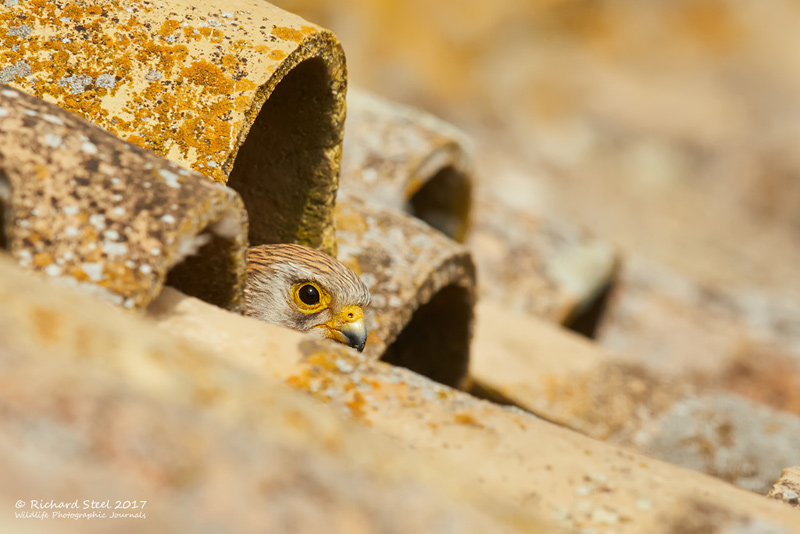After waking from the afternoon siesta, I stepped out of the darkness into the brilliant sunshine bathing the small balcony of my room. It did not look promising for our planned evening session. The sun was drifting slowly and downwards to the right and a strong breeze was blowing from the left. With wind and light coming from opposite directions we were going to struggle in the hide as the birds would be landing or tending to face away from us.
We were collected outside the hotel and a after a short journey, we head down a rough farm track to an abandoned and derelict building with a partially collapsed roof which was being used a nest site by a colony of Lesser Kestrel. A small hide, raised up on scaffolding had been constructed alongside of the building providing a birds eye view over the roof area. As predicted the light and wind were in completed opposite directions and the first kestrel there came into the land came in from behind us to land facing away from us and sat on the sloping tiles looking in the opposite direction. We were going to struggle for photos a little here. The photograph below gives a view from the hide to give you some idea of the scene before us.
Two things to note from this photograph. Firstly in the centre of the image is a male Lesser Kestrel facing away from us. The second is the Spotless Starling on the crest of the roof to the left. The Spotless Starling was very entertaining, as we sat in the hide waiting for the kestrels to appear, as it was singing continuously in winging fluttering full volume throughout our visit. It was also imitating the calls and songs of around a dozen different bird species and including Golden Oriole.
After the small disturbance of our arrival at the hide, the Lesser Kestrels quickly started to return. My estimate there was probably around 4 pairs nesting under the tiles on the side of the roof we could see and probably others on the other side of the roof.
Over the next 3 hours as the sun slowly dipped behind us, there was a steady stream of kestrels appearing in front of the elevated hide. Males would frequently arrive with giant centipedes to present to the female that would usually appear from under one of the terracotta roof tiles. It is obvious why these warmer areas are so productive for birds with the abundance of large insect prey. A feature that is notably absent from the cooler climate and more intensively farmed lands of the UK.
The wind being in the wrong direction was annoying as it not only prevented any flight photos but also on a few occasions we had pairs of kestrel mating on the tiles in front of us. However, it was always with their backs to the hide.
Given that we had plenty of time left on the trip, we decided we would book another evening session in the hide when the wind would be in a more favourable direction.
Back hotel we went straight into the evening meal which was particularly unmemorable and not great at all, before going through the evening ritual of sorting kit and images out. The alarm clock was set to stun for another early start in the morning.






























1 comment:
Hello,
nice post about wildlife photography...
thanks for share it.
Post a Comment